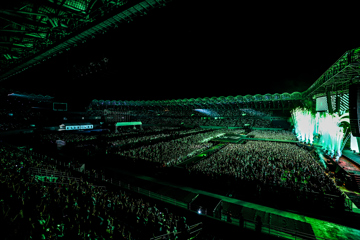Play Time
“I’m really interested in interaction and control... I’m interested in getting sound and video synthesisers and in how these things can be played.”
Creative minds, as a general rule, tend to be pretty playful. It's something that seems just so integral to the creative person. Like the painter's play of light and colour. The musician's tone and timbre. It's as if our internal creative forces all hinge upon experimentation, boundary-pushing and playful interaction. And it's not just the creative artists that have this quality, but creative thinkers across the board. They always seem to be unsatisfied in the most inspired way.
Enter Richie Cyngler, an artist who uses different soft and hardware to create interactive audiovisual pieces, with a strong preference for using open source materials. Open source? “Well, okay, so there's the free software movement,” explains Cyngler. “The idea is that software should be available freely. Open source refers to the source code that underlies that software. The code is open and available for people to change according to their needs.”
After becoming frustrated with the creative limitations of software such as Photoshop and Illustrator, Cyngler turned to open platforms. He became proficient in programs such as Pure Data and SuperCollider, which gave him the resources to program his own software and execute his concepts. Return the idea of play. “The great thing about the open source movement,” he explains, “is that distribution becomes really widespread, globally widespread, via the web, which means that a whole lot of people get a chance to experiment and play and contribute to the project.” What you end up with is a global dialogue where ideas are shared and people are able to customise software to suit their purposes. In Cyngler's case, to create art.
“I'm really interested in interaction and control,” he says, “I'm interested in getting sound and video synthesisers and in how these things can be played.” Cyngler invites his audiences to play as well. “I design tools for myself to play in a performance context, and for other people to play with in an installation context. So I'm really interested in using technology in direct and interactive ways.” And in doing so Cyngler says that his art seeks to challenge the view that the audience is made up of passive spectators. He endeavours to create projection art that sees the audience become an active participant in the work. He wants them to play. Play, play, play. And this is true of his piece in the upcoming Gertrude Street Projection Festival, where passers-by will be able to interact with photosensitive sensors that effect projections along the footpath. His installation was specifically designed for the festival. “It's an interesting challenge,” he notes. “It's interesting to work with different constraints in different contexts. I've had to think about the specific site and design a piece that's going to fit there.”
And so, just like all games need rules, so does the creative process need constraints. And if the game gets boring then change the game, or learn programmer code and write yourself a new one. Richie Cyngler's piece uses photosensitive sensors to detect movement, so bring a torch. It'll be more fun that way.
The Gertrude Street Projection Festival runs from Friday 20 July until Sunday 29, nightly 6pm, Gertrude Street, North Fitzroy.







